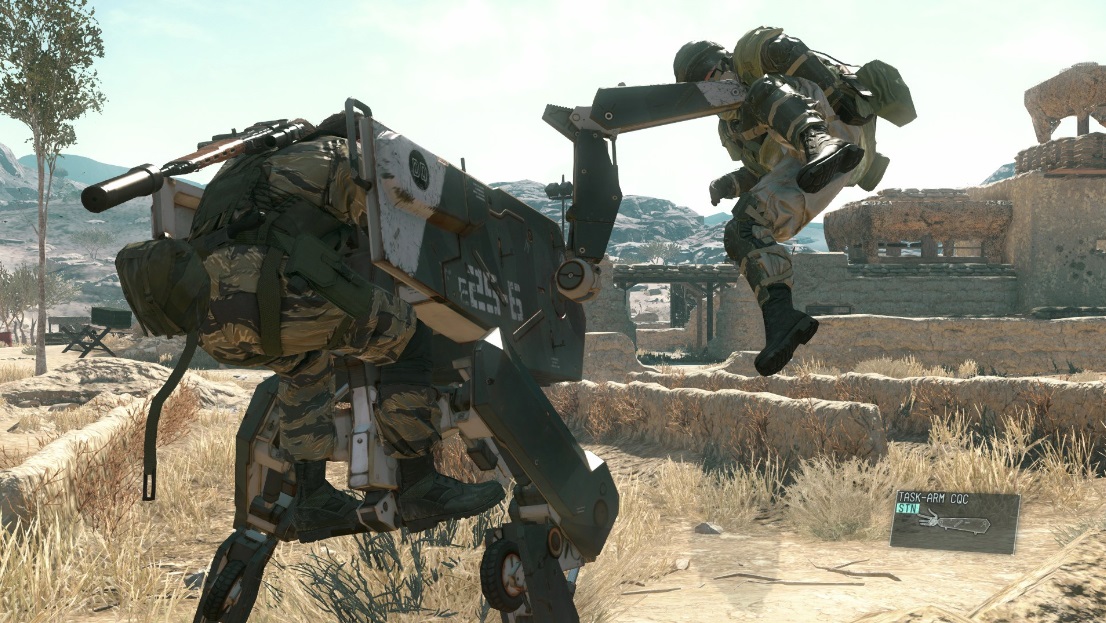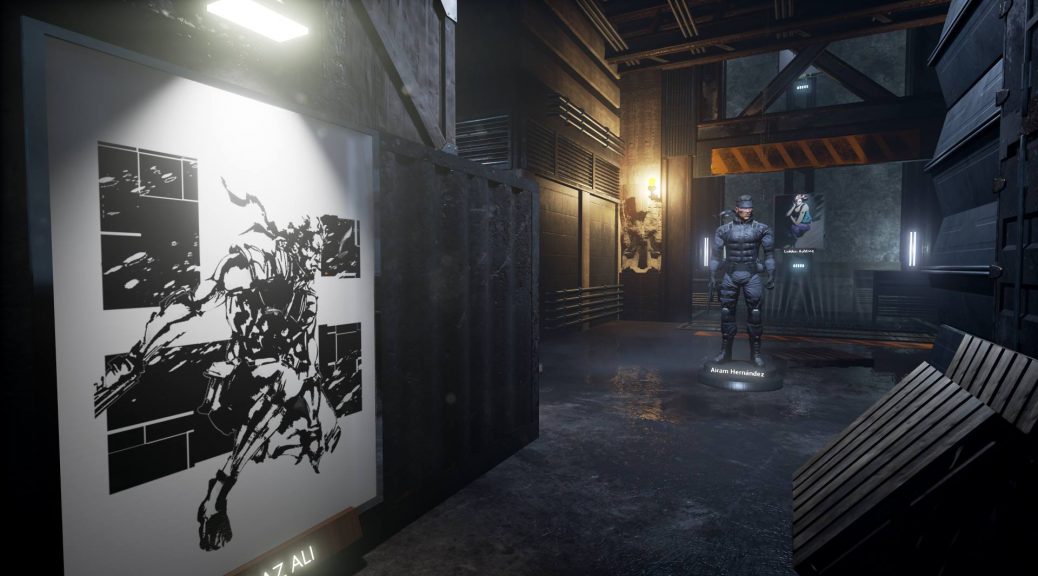the Metal Gear Solid demo – Destructoid
This may be the second weirdest forgotten game I ever talk about. The demo for Metal Gear Solid on the PS1 is not really a game in and of itself, and the full title it demoes is nowhere near forgotten. And who has nostalgia for a demo, anyway? It would seem, for all intents and purposes, that this will be a completely nonsensical article.
I’m not going to necessarily argue that point.
The Metal Gear Solid demo, which I can’t find anymore because I lost the demo collection disc it came on and cannot remember for the life of me what it was called, was a truly remarkable bit of gaming. Apart from being hands-down the best demo I’ve ever played, it somehow managed to be superior to most full retail games. Considering the demo only contained the first five rooms in the game, this was a hell of a feat.
Anyway, hit the jump to find out what the hell I’m talking about.
I’m not gonna do a Story/Gameplay/Why you’re not playing it division for this week, for obvious reasons.
Essentially, the MGS demo began at the very beginning of the game (meaning the first proper cut scene, not the optional animated pre-mission briefings) and ended with the death of the DARPA chief, Donald Anderson. If you’ve ever played MGS in its entirety, you probably understand that we’re not talking about a mindblowing amount of gameplay, here: Snake goes from the watery basement to the outside of Shadow Moses to a ventilation shaft to a tank hangar to an elevator to another ventilation shaft, and that’s it. An experienced player can get through this chunk of gameplay in less than five minutes, not counting cut scenes.
Yet, as someone who had never played the game — heck, who had never played any stealth game before, period — I could literally spend hours with this small slice of the complete title. The MGS demo did everything that a great demo should do. Literally, everything.
It set up the world and the characters (considering how important story is to the MGS series, enticing the player with interesting personalities and situations was an absolute must), it gave you a firm handle on the game’s main mechanics (Mei Ling’s adorably racist “da bwight dot in da middew is you, Snake” radar tutorial is present in its entirety), and it teased you into excitement to find out what happens right after the demo ends.
Most demos end on the same depressingly predictable note: you fight off some bad guys, enter a room, and — gasp! — all of a sudden a gigantic, ferocious-looking boss busts through a wall like the goddamn Kool-Aid Man and howls at you menacingly. As you mentally prepare yourself to kick the crap out of the goon, the screen slowly fades to black and you’re urged to purchase the full game. The “boss fade,” as I call it, is a reliable method of suddenly exciting your player before pulling the rug out and making them yearn for more. It’s really easy, it’s really effective, and it’s really unfair.
The Metal Gear Solid demo was nowhere near as manipulative. Without having to plop a gigantic boss fight in front of the player (who, of course, looks way more menacing and difficult in the demo than he ever is in the full game), the demo’s climax left me in incredible suspense simply by ending the demo after a really, really great cut scene.
Try to imagine the cinematic on its own, without thinking about the ultimate reasoning behind the events: after finally sneaking into Donald Anderson’s cell (thus completing the first stated objective of your mission), you get some solid answers regarding your mission to foil the terrorists: you’ll need a PAL key (“That card key…,” the woman in the next cell mutters to herself), some ID cards that work with your body’s own electric (though I distinctly remember the subtitles mistakenly said “electronic”) field, and so on and so forth. As Donald explains things to Snake, we see a redheaded woman doing sit-ups in the next cell. She begins to eavesdrop on the conversation. Suddenly, Donald makes reference to a nuke-equipped walking battle tank. “Metal Gear?!?,” Snake asks in his inimitable voice, mixed with equal parts badassity and total confusion. We see very grainy, blurry shots of what seems to be a really big mech of sorts. We can’t quite perfectly make out what we’re looking at, but we know that it’s dangerous, and frightening. Then, after a few uncharacteristically inquisitive statements, Donald suddenly has a heart attack! The controller rumbles as he lurches toward Snake, yelling, “WHYYY?!”
As Donald explains things to Snake, we see a redheaded woman doing sit-ups in the next cell. She begins to eavesdrop on the conversation. Suddenly, Donald makes reference to a nuke-equipped walking battle tank. “Metal Gear?!?,” Snake asks in his inimitable voice, mixed with equal parts badassity and total confusion. We see very grainy, blurry shots of what seems to be a really big mech of sorts. We can’t quite perfectly make out what we’re looking at, but we know that it’s dangerous, and frightening. Then, after a few uncharacteristically inquisitive statements, Donald suddenly has a heart attack! The controller rumbles as he lurches toward Snake, yelling, “WHYYY?!”
He finally drops to the floor, dead.
Snake kneels and calls the Colonel on codec.
The demo ends.
I came.
I mean, honestly, I can’t think of a better way to end a demo: we’ve met or heard reference to nearly all the main players in the plot, we’ve assumedly accomplished the first objective in our mission, and all of a sudden the hostage dies and though we’ve received the answer to a fair many questions, even more numerous and interesting ones have been raised. When the demo first ended, my sister and I literally wanted to rush out and buy a copy of the game as quickly as possible…but not QUITE as much as we wanted to immediately replay the demo and explore a bit more.
When the demo first ended, my sister and I literally wanted to rush out and buy a copy of the game as quickly as possible…but not QUITE as much as we wanted to immediately replay the demo and explore a bit more.
Beyond its incredible narrative tautness, the demo included more nonlinear gameplay, hidden secrets, and just plain awesome stuff than I could find in roughly 80% of the PS1 games I had access to back in 1999. On a second playthrough, I found out how to get on Shadow Moses’ outside balcony. It took me several tries to find all the hidden rations and items. I spent hours perfecting my technique, to get through the entire demo without alerting a single guard. I played through the demo three times until I realized there was a Socom hidden in the back of the truck outside Shadow Moses, which I then gleefully used on every guard in sight.
It’s easy for MGS veterans to talk about how Hideo Kojima has a borderline insane attention to detail, but back in 1999, I — an average gamer with no previous knowledge of the series — simply had no way of knowing: I presumed that I was to play a pretty standard Mission-Based War Game With A Badass Protagonist, and was nowhere near ready for the nonlinear, secret-filled awesomeness I received. I could go through the demo a dozen different times and, while I still had to use the same doors and shafts, I could get there a different way each time. I eventually derived more hours of gameplay from that meager demo than I did from all the full games I actually owned. After about a month of just playing the demo, Ash and I rented, then bought the full game, thus kicking off our joint crush on David Hayter.
I could go through the demo a dozen different times and, while I still had to use the same doors and shafts, I could get there a different way each time. I eventually derived more hours of gameplay from that meager demo than I did from all the full games I actually owned. After about a month of just playing the demo, Ash and I rented, then bought the full game, thus kicking off our joint crush on David Hayter.
It’s obviously not worth playing the demo now — much better to get the Essential Collection and play all three games in one fell swoop — but I have many unreasonably fond memories of the simple, brilliant demo of a game that would literally stick with me for the rest of my life.
In my segment of Destructoid’s Metal Gear Solid 4 review, I mentioned that my adoration from the game was borne out of the fact that I had been involved with the franchise since elementary school. I’ve had a personal relationship with the Metal Gear Solid series, for better or for worse, for around half of my life.
The MGS demo was the beginning of that relationship.
Ground Zeroes Wasn’t Just A Glorified Demo, It’s One Of The Best Metal Gear Solid Games Ever Made
By
Andy Kelly
The Phantom Pain’s prologue is a mini masterpiece.
At the southern edge of Cuba, along a rocky, rain-battered coastline, lies Camp Omega. In this grim US-run prison camp, detainees are beaten, humiliated, and brutally interrogated. They wear anonymous orange jumpsuits and have sacks pulled over their heads. Rats scurry between the bars of their cages. Invasive spotlights roam back and forth. It’s a stunningly bleak setting for a video game, and an obvious parallel to Guantanamo Bay—which, eight years after Ground Zeroes was released, is still operating thanks to an executive order signed by Donald Trump. Despite Hideo Kojima and Yoji Shinkawa’s fetishism for military hardware and weaponry, Metal Gear has always been strongly anti-war—and Camp Omega is the series’ most overt, provocative manifestation of that.
Ground Zeroes launched on PlayStation 3, Xbox 360, and Xbox One in March, 2014. Serving as a prologue to Metal Gear Solid 5: The Phantom Pain—which would be released in September the following year—it was somewhat controversial at the time. Some players balked at the idea of paying $30 for what, in their eyes, was a glorified demo. There’s only one level—the aforementioned Camp Omega—and you can beat the main mission in an hour. Maybe even less. But there’s a lot more to Ground Zeroes, which becomes clear when you finish that first mission and realise that your game completion is only at a paltry 8 percent. When I was done with it, and felt I’d seen everything, Steam told me I’d played it for a grand total of 35 hours. Some played it for hundreds. Not bad for a demo.
Related: Game Developers Need To Get Over Aliens
In Ground Zeroes you play as Big Boss: a former CIA operative, a legendary soldier, and the genetic father of Solid Snake. After being betrayed by the US government, he forms his own private army—the creation of which leads him to Camp Omega on a cold, dark, stormy night. Two prisoners are being held there, and it’s your job to locate and extract them. However, the brilliance of Ground Zeroes is that there are countless ways to achieve this objective. This was a testing ground for the freeform, open-ended stealth gameplay that Kojima Productions would go on to perfect in The Phantom Pain, and safely liberating these two captives is left entirely up to you. This is what ultimately made Ground Zeroes worth spending $30 on. It’s one of gaming’s greatest stealth sandboxes.
Two prisoners are being held there, and it’s your job to locate and extract them. However, the brilliance of Ground Zeroes is that there are countless ways to achieve this objective. This was a testing ground for the freeform, open-ended stealth gameplay that Kojima Productions would go on to perfect in The Phantom Pain, and safely liberating these two captives is left entirely up to you. This is what ultimately made Ground Zeroes worth spending $30 on. It’s one of gaming’s greatest stealth sandboxes.
Camp Omega is a remarkably detailed, interactive space, offering a multitude of clever, creative ways to evade, outwit, distract, or subdue the gun-toting guards patrolling the camp. These aren’t just robotic drones mindlessly pacing back and forth, either: their AI is smart, reactive, and convincing. If they hear a suspicious sound, they’ll respond with a mixture of curiosity and trepidation. Sound the alarm and they’ll form up in groups and work together to flush you out. They can surprise you, suddenly looking over their shoulder just when you think the coast is clear, or sneezing and giving you a brief, merciful window to slip by them. They’re a formidable adversary, which makes sneaking through the camp and securing your objective without being seen supremely rewarding.
They can surprise you, suddenly looking over their shoulder just when you think the coast is clear, or sneezing and giving you a brief, merciful window to slip by them. They’re a formidable adversary, which makes sneaking through the camp and securing your objective without being seen supremely rewarding.
Camp Omega is tiny compared to the huge, sweeping chunks of open world featured in The Phantom Pain—but I love that about it. The smaller scale means you can really take the time to learn every inch of the place, and 30 hours in you’ll still be finding new shortcuts, hiding places, and security flaws to exploit. It’s a brilliantly designed stealth playground, with vents to crawl through, walkways to sneak across, towers to climb, and trucks to hide in the back of. It reminds me a lot of Liberty Island, the opening level of classic immersive sim Deus Ex, in that it’s a relatively small, contained space, but endlessly, brilliantly replayable thanks to its combo of intricate level design and rich systems-driven gameplay. It’s amazing how much Ground Zeroes squeezes out of one location.
It’s amazing how much Ground Zeroes squeezes out of one location.
As well as the main story there’s a selection of so-called Side Ops, which reuse Camp Omega in some interesting ways. In each mission the layout of the camp, the patrol routes of the guards, and the weather and time of day can be radically different. Objectives include identifying and assassinating a pair of war criminals. Another mission sees you playing as Raiden, exposing body-snatching aliens that have disguised themselves as guards. Ground Zeroes also pays tribute to the original Metal Gear Solid in a mission where you have to recreate key moments from the Shadow Moses Incident. This optional content is a mix of traditional, straight-faced objectives and typically absurd, self-referential Kojima humour—and the majority of it is just as replayable as the main mission.
I love The Phantom Pain, but it’s so overwhelmingly big that returning to the smaller, more focused Ground Zeroes is a breath of fresh air. Camp Omega is a level you can master, and the deep, dynamic stealth makes every run feel wildly different. Playing it also reminds me of the Metal Gear Solid demo that came with that one issue of Official PlayStation Magazine that everyone bought. I’d play that short taster of the full game repeatedly, for hours on end, uncovering every possible secret and new way to play it I could. A lot of people might have objected to the concept of Ground Zeroes, but it’s an experiment I’d love to see the developers of similarly rich, replayable stealth games repeat. It might be a demo, but it’s still one of the best Metal Gear games ever made.
Camp Omega is a level you can master, and the deep, dynamic stealth makes every run feel wildly different. Playing it also reminds me of the Metal Gear Solid demo that came with that one issue of Official PlayStation Magazine that everyone bought. I’d play that short taster of the full game repeatedly, for hours on end, uncovering every possible secret and new way to play it I could. A lot of people might have objected to the concept of Ground Zeroes, but it’s an experiment I’d love to see the developers of similarly rich, replayable stealth games repeat. It might be a demo, but it’s still one of the best Metal Gear games ever made.
Next: The Last Sanctuary Is One Of The Most Haunting Post-Apocalyptic Games I’ve Ever Played
Stanley SBD20S2K
drill/driver test
INSTRBY
- Details
-
Construction and repair
-
-
2431
The predecessor of this model will be considered a similar model with a collector motor — Stanley STDC18LHBK. A very successful screwdriver, perfectly balanced in terms of performance and sold at a very attractive price. And now — the same thing, but in a brushless design. nine0018
A very successful screwdriver, perfectly balanced in terms of performance and sold at a very attractive price. And now — the same thing, but in a brushless design. nine0018
The battery is a slider type, with a very wide base, thanks to which the tool is stable on a horizontal surface. He would also add an anti-slip pad to the bottom of the battery, then he will not go anywhere, even if the surface is sloping. And there is still not enough battery indicator, but it must be borne in mind that the tool is budgetary and it is perhaps not very reasonable to demand from it the presence of all conceivable and unthinkable “options”. Somewhere, the manufacturer still had to save money, otherwise this model would have cost more. Apparently, the absence of an indicator is just one of the ways to reduce the cost. nine0018
See catalog
Specifications:
| Battery type | Li-Ion |
| Voltage | 18V |
| Battery capacity | 1. 5 Ah 5 Ah |
| Max. torque | 55 Nm |
| idle speed | 0-430/1700 rpm nine0031 |
| Cartridge | 1.5-13 mm |
| Weight | 1.5 kg |
| Equipment | 2 battery, charger, case |
Among the interesting features, it is worth noting a two-speed gearbox, a large number of torque adjustment steps (23 plus a drilling step), a keyless chuck with a run-out brake.
nine0017 There is a backlight, and the LED is located very competently, in the lower part of the handle — so there is less shading of the working area. Next to the LED is a spring bit holder. A very useful thing when you work on a stepladder and you have to constantly put either a drill or a bit.
The case is rubberized, and very competently. And it fits in the hand like a glove and, being laid on its side, does not slip and does not touch the surface with the body.
Exploring Real Opportunities
To begin with, we tried to make a «step» to assess how suitable the screwdriver is for working with small fasteners. We took black self-tapping screws 60 mm long and began to screw them in, three copies at each odd position of the torque limiting clutch regulator. And here’s what we managed to find out — the self-tapping screws are completely recessed in the 13th position of the coupling (recall, there are 23 of them in total). That is, the increase in torque goes very smoothly, which means that the screwdriver is perfectly adapted for small fasteners, it will not overtighten it. nine0018
After that, we tried to evaluate how effectively this model copes with large «grouse». To begin with, we took a “grouse” with a size of 10 × 160 mm — this screwdriver easily drives it into a double pine beam right up to the head. Then they tried to do the same on a “grouse” with a size of 12 × 240 mm — it is recessed by about half, but already in the drilling mode. The declared hard torque is 55 N * m, as you can see, this is enough for work accompanied by very high loads. nine0018
The declared hard torque is 55 N * m, as you can see, this is enough for work accompanied by very high loads. nine0018
Another power and clutch test is drilling wood with a 35 mm spade bit. This exceeds the permitted capacity of the tool (30 mm). Nevertheless, he coped with 35 mm, however, the protection obviously worked several times and the engine stopped. It is not surprising, the load was serious, we drilled not some kind of board, but a “hundred” beam, and through and through.
Based on test results, Stanley’s new screwdriver is not a one-size-fits-all «specialty» («furniture assembler» or «roofer»), but a versatile tool for a wide range of applications. It is quite logical, because the target audience of the Stanley tool is primarily small construction teams, and the screwdriver is one of the types of tools most intensively exploited by such teams. nine0018
Expertise
The battery contains only cells and switching wires, there is no control electronics (1). This suggests that the battery is compatible with the previous brushed motor model. Banks — Samsung INR 18650-13B (2), judging by the data found on the Internet, the maximum output current is 25 A. Which is fully confirmed by the test results — the tool spins large “grouses” quite confidently, and this requires a large current. The conductive plates are welded by contact welding, everything is done very soundly and accurately. Even protection against re-soldering is provided. nine0018
This suggests that the battery is compatible with the previous brushed motor model. Banks — Samsung INR 18650-13B (2), judging by the data found on the Internet, the maximum output current is 25 A. Which is fully confirmed by the test results — the tool spins large “grouses” quite confidently, and this requires a large current. The conductive plates are welded by contact welding, everything is done very soundly and accurately. Even protection against re-soldering is provided. nine0018
The jar and contact assembly is attached to the bottom of the battery case with adhesive tape (3). Moreover, the glue is of very high quality, it holds an almost stranglehold and allows re-gluing.
Charger transformer and also very simple structurally (4). It does not have a forced cooling fan, and the air circulation holes are quite wide, so the charger should not be left in cluttered places. Theoretically, it is impossible to exclude a situation in which a small carnation or self-tapping screw can accidentally fall into the case through the ventilation holes, and this is best avoided. nine0018
nine0018
Now let’s move on to the most interesting thing — we disassemble the screwdriver itself.
Single-sleeve quick-release chuck. The manufacturer is not identified by the marking on the case. It is fixed on the threaded shaft and additionally with a Torx screw, very securely. Thread — 1/2 * 20 UNF (20 threads per inch). This is a very important point, which clearly confirms that the machine is designed for harsh operating conditions. For household screwdrivers, the shaft diameter is usually 3/8 », and this significantly limits their use, because you cannot count on high torque. Cases when tools with a literally rolled shaft are brought to the service are not uncommon — this happens if the efforts of the tool itself are not enough and the fasteners are turned manually, on a locked spindle. The thinner the shaft, the worse it holds such loads. nine0018
Remove the body half. First, the motor is truly brushless. Secondly, the control electronics are really in the screwdriver, as we expected. Thirdly, the wiring is done very carefully, nothing is pinched anywhere, there is no confusion anywhere. Fourth — the engine and the «brains» are clearly a single part, the connection is one-piece (you need to solder three wires). With brushless motors, this solution is very common.
Thirdly, the wiring is done very carefully, nothing is pinched anywhere, there is no confusion anywhere. Fourth — the engine and the «brains» are clearly a single part, the connection is one-piece (you need to solder three wires). With brushless motors, this solution is very common.
nine0017
This is a shift slider. Note that it is spring loaded. Do you know what is the advantage of such a solution? It greatly simplifies operation. When switching, it often happens that the satellites do not engage with the crown and, as it were, “freeze”, there is no direct switching. In this case, you need to turn on the engine for a split second to change the position of the gears, and try again. But everything is much simpler if you work with Stanley SBD20S2K. You move the slider, and even if the gears are not engaged, then the first time you turn on the spring, it will still press them and the desired gear will turn on on its own, without unnecessary manipulation by the operator. nine0018
But the connection to the windings looks somehow not very technologically advanced. Just crimped the contacts, without any soldering. Yes, they crimped very reliably, but what prevented these points from being additionally soldered, as is done on many branded instruments? It is doubtful that the desire to reduce the cost of construction — there are many other places where you could save more serious amounts.
Just crimped the contacts, without any soldering. Yes, they crimped very reliably, but what prevented these points from being additionally soldered, as is done on many branded instruments? It is doubtful that the desire to reduce the cost of construction — there are many other places where you could save more serious amounts.
So far, we have not gone far, and we can only form first impressions. However, they also say that the new Stanley screwdriver is not so simple. However, in order to make a more accurate representation, it is necessary to go further, to disassemble the gearbox. nine0123
We remove the engine, we see the metal drive gear.
Now we study the reducer. The first stage (the one immediately behind the engine) is metal gears. And there are five of them here, which is great, because the torque is distributed more evenly. It happens that there are only three of them, and besides, they are made of plastic — such a solution has previously been found on models of even the main world brands. The more gears, the lower the specific load on each of them. nine0018
The more gears, the lower the specific load on each of them. nine0018
We disassemble the gearbox in detail and see that only the body is plastic in it. The rest is metal, so there is no doubt about the reliability of the design.
Six balls — torque limiting clutch element. Nearby is the “comb” along which they pass when the clutch is activated. You can see traces of the movement of the balls along the protrusions of the «comb» — during our tests, the clutch worked repeatedly. This is alarming, because the noticeable wear of the “comb” will later affect the moment of operation of the clutch and lower it — if there is a depression on the “comb”, then it will be easier for the ball to jump, which it will definitely do. True, the wear rate of the «comb» is not linear, it decreases exponentially with time. To understand why, try imagining that you are filing a triangular part. The farther, the more metal must be removed to pass the same height. nine0018
However, the question arises — why did such wear appear on the new tool that is noticeable to the naked eye? We assume that the reason is as follows. This sample is provided by Stanley Black & Decker and is clearly from a demo tool kit. Have you seen how these demonstrations go? We have seen more than once. A screwdriver is constantly working at the limit of its own capabilities, no one gives it an easy job in the form of twisting small self-tapping screws. It will not be spectacular, so they always show how he drives large “grouse” to the full depth. In general, in demonstrations, the ratchet works hundreds of times more often than in real use. Hence the wear, which in normal mode will appear, probably, only after a few years of operation. nine0018
This sample is provided by Stanley Black & Decker and is clearly from a demo tool kit. Have you seen how these demonstrations go? We have seen more than once. A screwdriver is constantly working at the limit of its own capabilities, no one gives it an easy job in the form of twisting small self-tapping screws. It will not be spectacular, so they always show how he drives large “grouse” to the full depth. In general, in demonstrations, the ratchet works hundreds of times more often than in real use. Hence the wear, which in normal mode will appear, probably, only after a few years of operation. nine0018
Ball bearing at the shaft exit, just behind the spindle on which the drill chuck is placed. It should be here, a surprise (and an unpleasant one) would be the absence of a bearing in this place.
Motor housing with large gaps. This means that the screwdriver requires careful handling. It should not be thrown on heaps of construction debris, especially where angle grinders worked. Fine metal dust and sawdust have a chance to get inside and become magnetized to the rotor. nine0018
Fine metal dust and sawdust have a chance to get inside and become magnetized to the rotor. nine0018
Inside the rotor are four powerful neodymium magnets. They are located in a «square» in special channels of the rotor. As a result, it is able to attract small metal objects to itself. To reduce this effect, the ends of the rotor are covered with plastic covers. The magnetic force at these points is maximum, the covers are designed to eliminate the risk of metal dust and other unnecessary things sticking to the rotor. In general, protection is provided here, but it does not negate the need for careful treatment of the instrument. nine0018
Stator with six windings. On brushless motors of expensive tools, there are nine of them, in this case we see a reasonable compromise between the technical capabilities of the motor and its cost.
Terminals
Stanley has once again confirmed and clearly demonstrated that a budget tool can quite deservedly claim the title of a professional one. The design of the new SBD20S2K screwdriver cannot be called otherwise than solid — no obvious weaknesses and signs of saving on materials at the expense of quality were found. nine0018
The design of the new SBD20S2K screwdriver cannot be called otherwise than solid — no obvious weaknesses and signs of saving on materials at the expense of quality were found. nine0018
Source: master-forum.ru
Stanley
Test
Interesting in the catalog
Review
Powerful and affordable 21V lithium powered screwdriver / Tools / iXBT Live
iXBT.com projects require cookies and analytics services.
By continuing to visit project sites, you agree to our
Cookie Policy
Greetings to everyone who looked at the light. The review will focus, as you probably already guessed, on a fairly powerful screwdriver powered by a Li-Ion battery with a total voltage of 21V. In the review, as usual, there will be a detailed description, disassembly and demonstration of the possibilities, so if you are interested, you are welcome under cat.
General view of the screwdriver:
You can find the current price HERE
. It is very cheap for such a device.
It is very cheap for such a device.
I inadvertently ordered a model with one battery, so I recommend that you look at the option with two batteries — HERE
Contents:
— General view and brief performance characteristics Parts
— Screwdriver Power
— Charger
— Testing
Brief Specifications:
— Case — impact resistant rubberized plastic
— Nominal / maximum voltage — 18V / 21V (5S)
— Battery type — 5 Li-Ions connected in series f / f 18650
— Battery capacity — about 1300mah
— Chuck type — keyless
— Chuck lock — no
— Supported diameter — 0.8-10mm
— Gearbox — planetary, metal gears
— Maximum torque — 45Nm
— Number of torque steps (ratchet) — 15 + 1
— Gear selector — two-position, two speeds (450/1550 rpm) min)
— Speed control — smooth, depending on the degree of pressing the trigger
— Reverse — yes
— Battery level indicator — no
— Electric motor — RS-550S-18v
— Backlight — yes (LED)
— Accessories:
— — — plastic case — yes
— — — additional battery — no
— — — charger — yes
— — — holster — no
— — — bit set — no
— Dimensions — 195mm*165mm*57mm
— Weight — 1120gr
Contents:
— screwdriver
— charger
— plastic case
— instructions
Despite the rather low cost, the screwdriver comes in a compact plastic case:
The case is quite durable and comfortable, without foreign odors. Inside there is free space for an additional battery and consumables. Unfortunately they are not included. I recommend looking at a model with an extra battery. It is slightly more expensive, but much more practical to use (links at the beginning / end of the review). nine0018
Inside there is free space for an additional battery and consumables. Unfortunately they are not included. I recommend looking at a model with an extra battery. It is slightly more expensive, but much more practical to use (links at the beginning / end of the review). nine0018
For additional protection during transportation, all elements were additionally wrapped in a layer of “pimples”:
The instruction is quite detailed in English, inside there is a complete schematic device with a parts catalog:
To be honest, in the instructions for Chinese screwdrivers I see this for the first time . This is a definite plus, because in the event of a breakdown, this part can be ordered without problems at various sites.
In total, the equipment is good. Unfortunately, I mistakenly ordered a model without an additional (replaceable) battery, because I did not read the description carefully. The price with an additional battery is slightly higher, but this difference will more than pay for the convenience of use. nine0018
nine0018
Dimensions:
Screwdriver dimensions are small, about 195mm*165mm*57mm:
operating characteristics, the surveyed screwdriver is somewhat more compact:
The weight of the screwdriver is small — about 1120g (1.12kg), and the battery module weighs about 300g:
less than 2 kilograms(due to battery). nine0018
appearance:
Outwardly the screwdriver looks pleasant:
The assembly is solid — the case does not creak, does not play, in general, a feeling of quality product is created:
The handle was performed according to the type has rubberized inserts, which greatly facilitates the grip during work:
I would like to note that the main advantage of screwdrivers with a pistol grip and an “external” battery is the correct weight / balancing of the tool, which makes it much more pleasant and more convenient to work with them than screwdrivers in which batteries are placed in the handle (most screwdrivers with 3S and sometimes 4S batteries). In addition, the handle is much thinner, which is why the screwdriver sits more confidently in the hand and, in my opinion, the brush gets tired of it a little less. nine0018
In addition, the handle is much thinner, which is why the screwdriver sits more confidently in the hand and, in my opinion, the brush gets tired of it a little less. nine0018
The location of the reverse switch is traditional, you can change bits or drills in a couple of seconds. It is enough to hold the conical part of the cartridge with the palm of your hand and at the same time hold the bit / drill with your thumb and forefinger. With a certain skill, changing the tool takes a matter of seconds. The reverse stroke is quite soft, the middle position is designed to block the button during transportation or storage:
Directly under the cartridge there is an LED designed to illuminate the working area. Unfortunately, some of the light flux is blocked by the lower part of the cartridge, so I would like to see the LED in the battery module, as implemented in the Suntol SND235 screwdriver. Despite this, the backlight is enough to control the drilling / tightening process. nine0018
The gearbox housing is not metal, as it may seem at first sight. This is just a decorative overlay that additionally fixes the case and gives some sophistication to the appearance:
This is just a decorative overlay that additionally fixes the case and gives some sophistication to the appearance:
The mode switch is located on the upper end of the case: – 450 rpm in first gear (tightening) and between 0 – 1550 rpm in second gear (drilling). It is easy to guess that at the first speed the torque will be the maximum. nine0018
To help professional craftsmen or just novice users, there is a safety clutch for 15 positions + 1 position without restrictions:
This is a very useful feature that is found in almost all screwdrivers and allows you to work with various “brittle” materials, such as drywall, plastic , plywood, excluding their damage. Those. it is only necessary to select a suitable maximum force once, at which the load-bearing / fastening elements will not be destroyed and continue to work without any fear. nine0018
This model has a keyless chuck that is attached to the shaft with a screw:
While the tool is new, I recommend lubricating the threads of the chuck and the control screw so that if it becomes necessary to disassemble, do not waste time and effort pulling them off. Do not forget that the control screw is left-handed (unscrewed to the right), and the cartridge is right-handed (unscrewed to the left):
Do not forget that the control screw is left-handed (unscrewed to the right), and the cartridge is right-handed (unscrewed to the left):
There is an inscription on the butt end of the cartridge, judging by which it is possible to clamp a cutting tool with a diameter of up to 10 mm. In fact, the maximum tool diameter is about 10.6mm:
There seems to be no beating of the cartridge, as far as I can tell from a small test with a sweep (video at the end of the review). But it all depends on the specific instance.
The battery module is attached to the screwdriver using two guides and one locking button:
Fastening is simple and reliable, there are no backlashes in operation. Current collectors are thick and wide enough to minimize contact losses:
Installing the battery is very easy. To do this, insert the battery into the special guides and push it until it clicks:
At the back end of the screwdriver there is a kind of lanyard designed to hold the tool on the hand or belt hook:
This is necessary when working at height, when it is not possible to put the tool next to it. Although it is worth noting that in this form the implementation of this function is “so-so”. I recommend replacing the lanyard with a special collar (latch) or ring.
Although it is worth noting that in this form the implementation of this function is “so-so”. I recommend replacing the lanyard with a special collar (latch) or ring.
Now a few words about the battery module. An assembly of five series-connected Li-Ion batteries with a nominal / maximum voltage of 18V / 21V (5S) is installed here. At the end of the charge, the voltage on each battery is 4.2V, and since there are five of them, the total voltage after charging is 21V. After some time, the voltage on each bank drops to the nominal 3.6-3.7V, regardless of whether batteries were used or not. In total, this gives just 18V. Of the advantages of 5S assemblies, one can note a higher operating voltage, and therefore the presence of a more powerful electric motor with high torque. nine0018
Disassembly and main parts:
Since I deal with this kind of tools quite often, in order to appreciate all the innovations and the level of quality of Chinese creations, I decided to disassemble the screwdriver. The case, as usual, is tightened with the usual screws «asterisks». This gives some inconvenience during disassembly, but with the appropriate bits / screwdrivers, there should be no problems. It is necessary to unscrew 12 screws and remove the decorative trim, after which the screwdriver body will open into two halves and the “guts” will become available:
The case, as usual, is tightened with the usual screws «asterisks». This gives some inconvenience during disassembly, but with the appropriate bits / screwdrivers, there should be no problems. It is necessary to unscrew 12 screws and remove the decorative trim, after which the screwdriver body will open into two halves and the “guts” will become available:
General build quality is good: high-quality molding of the housing made of high-impact plastic with a good fit and without all kinds of “burrs”, the presence of stiffeners, reliable fastening of rubberized inserts, abundant lubrication on most elements, high-quality soldering, no flux residues on the contacts and wires of good section . I would like to note that with the same power of the devices, with an increase in the operating voltage, the current consumption and, consequently, the heating losses decrease. In this regard, the requirements for the cross-section of wires in such models are not so strict. I have no complaints, although perfectionists can replace the wires with thicker ones made of oxygen-free copper. nine0018
nine0018
This model has a 550mm QLT MOTOR RS550-18V commutator motor, powered by 18V:
The main advantages of the motor include good power (torque) and higher revolutions compared to 12V counterparts.
The button-regulator is designed for 16A (2-24V):
This button has a three-position switch, in the extreme left / right position of which the direction of rotation of the cartridge changes, and in the middle — the button is fixed to protect against accidental pressing during transportation or storage . The button travel is quite soft, which makes it easy to adjust the speed in a very wide range (0 — 450 rpm at the first speed and 0 — 1550 rpm at the second speed). nine0018
Chuck with gearbox look like this:
The gearbox here is planetary, three-row. The undoubted advantage of the design is all-metal gears (satellites, crown and sun gear pressed onto the motor shaft) and an abundant amount of lubricant:
The third row of gears is also made of metal:
This design is also due to a fairly powerful electric motor. This is a huge plus, because some branded screwdrivers have a first row of plastic gears, such as the Hitachi DS12DVF3. nine0018
This is a huge plus, because some branded screwdrivers have a first row of plastic gears, such as the Hitachi DS12DVF3. nine0018
The gearbox has its own gearbox, i.e. speed and torque are not electronically controlled, but by changing the gear ratio of the gears. To do this, in the upper part of the gearbox there is a shift lever — normal / low gear.
If anyone is interested, here are two small videos about planetary gears:
And also the whole movie:
The chuck shaft is mounted on two bearings: on the inside of the gearbox on the sleeve (sliding bearing), on the outside — bearing rolling of the closed type. There is a lock washer inside the gearbox:
The limiting clutch looks like this:
Its construction is incredibly simple: on the one hand, a rigid spring presses, on the other there are two pairs of hardened balls. In the center of the coupling there is a thread that allows you to twist / unscrew the stop, thereby changing the spring force. The more we twist, the more the spring presses on the balls. The second pair of balls is hidden inside the housing and rests against the third row of the gearbox. The stronger the spring presses on the balls, the more difficult it is for them to slip through the gearbox stops. nine0018
In the center of the coupling there is a thread that allows you to twist / unscrew the stop, thereby changing the spring force. The more we twist, the more the spring presses on the balls. The second pair of balls is hidden inside the housing and rests against the third row of the gearbox. The stronger the spring presses on the balls, the more difficult it is for them to slip through the gearbox stops. nine0018
This is what it looks like:
You can also see the closed rolling bearing on the shaft.
Power screwdriver:
As mentioned earlier, the main highlight of this screwdriver is powered by five lithium batteries (5S), as a result of which we have increased torque and higher speeds. I have previously repeatedly mentioned the advantages of lithium power supplies (Li-Ion / Li-Pol) over nickel (NiCd), so I will not repeat myself.
Screwdriver battery module looks like this:
The battery is quite compact because the batteries are arranged horizontally. From the front edge there is a button with a latch. To connect the charger, there is a special DC 5mm connector located on the back:
From the front edge there is a button with a latch. To connect the charger, there is a special DC 5mm connector located on the back:
The weight of the battery is very small, about 300g:
Here is a comparison of battery modules. To the left of the previous Suntol SND235 screwdriver, visible in the center, to the right of the Bosch 18V screwdriver:
The battery box is attached with 4 self-tapping screws. Five Li-Ion batteries f/f 18650 (18mm diameter, 65mm length) are installed inside:
The batteries in the reviewed battery are not marked as such. Only the capacity is 1300mah and the production date is October 2017. Perhaps somewhere under the heat shrinkage the marking is hidden, but I’m too lazy to open it. A nice bonus is the presence of a special holder \ holder for 5 cans, which protects them from mechanical influences (shaking, falling) and inter-can short circuit. There is also good news for those who plan to convert the battery to a more capacious one — there is a small gap between the case and the batteries, which allows you to connect the «new» banks in a handicraft way using soldering. nine0018
nine0018
When disassembled, the battery module looks like this:
There are no complaints about the quality of the battery pack: the current collectors are of sufficient thickness and strength, the connection of the cans is made by spot welding through a nickel tape, there is a protection board (protection against overcharge / overdischarge / high operating current / short circuit), power mosfets are applied with a good margin. The only thing I would like to note is the black wire connecting the common minus of the battery assembly with the BMS board, I would like a larger cross section:
Larger BMS 5S board:
The power mosfets are paralleled and rated for 30V/100A, so you don’t have to worry about overheating. CellWise’s CW1053 protection controller IC monitors the voltage on each cell and protects them from overcharge, overdischarge (2.7V) and interbank short circuit (SC). A shunt in the form of a high-precision resistor R003 at the output of the board controls the operating current and turns off the load (motor) if the operating current is exceeded or if the output is short-circuited. The controller board has an auto-recovery function, i.e. no protection interlock (BMS board is self-healing). There is no hint of balancing the cans, this is just a protection board against overcharging, overdischarging and maximum current. I deliberately discharged one can a bit and as a result, it remained undercharged. nine0018
The controller board has an auto-recovery function, i.e. no protection interlock (BMS board is self-healing). There is no hint of balancing the cans, this is just a protection board against overcharging, overdischarging and maximum current. I deliberately discharged one can a bit and as a result, it remained undercharged. nine0018
Well, a few words for our «sofa» theorists. As I have repeatedly said, in some branded screwdrivers, such as Bosch, there is no protection board at all, not to mention the balancing of cans:
Therefore, you should not idolize all brand products indiscriminately.
The actual battery capacity is slightly lower than stated. The 1A discharge test in the iCharger i208B model charger and balancer showed a result of about 1220mah:
It is quite possible that one of the cans has a slightly lower capacity, so it becomes the limiting factor. The screenshot clearly shows that after 16V the voltage curve drops sharply to one volt, i.e. the protection on one of the cans worked, but strangely, it did not completely de-energize the output. Those. in fact, the average voltage on the banks is about 3.4V and there is a small margin of capacity, but on one it is about 2.8V. This is the main disadvantage of multi-cell batteries — the more cells, the lower the reliability and the more difficult it is to select cells with equal parameters. In any case, you can safely count on a capacity of 1200mah. nine0018
Those. in fact, the average voltage on the banks is about 3.4V and there is a small margin of capacity, but on one it is about 2.8V. This is the main disadvantage of multi-cell batteries — the more cells, the lower the reliability and the more difficult it is to select cells with equal parameters. In any case, you can safely count on a capacity of 1200mah. nine0018
Charger:
To charge the battery, a power adapter with a Euro plug is included. The cable length is about 1 meter, and at the output there is a vandal-resistant DC 5mm connector:
The adapter is designed for a maximum output of 21V / 1.3A:
The indication is simple — green (charged) and red (charged). Charging current is about 0.75A:
With an average capacity of cans of 1300mah, such a charging current is the most optimal for them. A current equal to 0.5-0.7C is considered safe, where C is the capacitance. At the end of the charge, the voltage on all banks is within normal limits. It must be remembered that the BMS board is not balanced and a slight imbalance may appear over time. With the active use of a screwdriver, I recommend going through each bank separately every six months. The algorithm is simple: charge with a standard adapter “all the way” until the green indicator lights up, and then go through all the banks separately with a simple charge board based on the TP4056 controller or a similar one. This procedure will equalize the voltage and reduce and reduce the loss of usable capacitance to a minimum. nine0018
With the active use of a screwdriver, I recommend going through each bank separately every six months. The algorithm is simple: charge with a standard adapter “all the way” until the green indicator lights up, and then go through all the banks separately with a simple charge board based on the TP4056 controller or a similar one. This procedure will equalize the voltage and reduce and reduce the loss of usable capacitance to a minimum. nine0018
Screwdriver testing:
I will not test the screwdriver for the number of screwed screws, because it takes a lot of time and requires the nth number of screws and bars. In a short video there will be a demonstration of torque by tightening various self-tapping screws, incl. «compact wood grouse», as well as a test for the runout of a cartridge using a reamer:
Pluses:
+ all the advantages of lithium power supply (low self-discharge, dimensions, weight, low cost, high maintainability) nine0212 + high torque
+ good workmanship, comfortable rubberized handle and main body
+ correct weight/balance
+ presence of a two-position switch (good traction or rpm)
+ all-metal planetary gear
+ built-in lighting
+ correct protection due to the presence of a battery monitoring system (BMS)
+ a good battery capacity (about 1. 2Ah)
2Ah)
+ the presence of free space in the battery (the ability to independently replace cans with more capacious ones)
+ Price
Controversial points:
± no additional battery (for such a price of norms, see option with additional battery)
± the more cells in the battery, the lower the reliability (performance vs reliability)
± built-in the backlight is not located on the battery (lights well, but could be even better)
± no battery balancing (long charge time vs battery capacity)
Cons:
— no battery level indicator
— non-branded batteries
— no normal belt mount
Conclusion: this screwdriver model is good, especially with an additional battery. Compact, powerful, with a good case — one might say, almost ideal. Of the shortcomings, only nameless batteries can be noted, but replacing them with 2.5-3Ah will not be difficult. There is enough power (torque) for any task, so whoever is looking for a fairly powerful model, I recommend taking a closer look . ..
..
You can buy this model here
I recommend looking at the option with two batteries — here
Services. Follow the link and register in the ePN or Admitad program and return an average of 5-10% of the purchase amount.
News
Publications
Despite the fact that the attackers once again did not take a very creative approach to the matter, the number of victims who gave them access to their personal accounts is increasing every day. Let’s…
While I continued to use the 27” Azerty DS-2702 monitor, the idea
In the catalog of the well-known Chinese manufacturer Azerty, there is one more model that calls…
Chinatown is one of the most picturesque districts of Singapore. noisy streets,
Buddhist temples and pagodas, flavors of Chinese cuisine, an endless procession
shops with Chinese goods. The best time for…
Hyundai H-LED50BU7003 is a 4K TV with Yandex.TV on board and, accordingly, Alice’s voice assistant.
